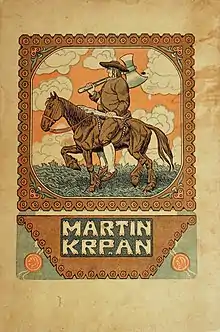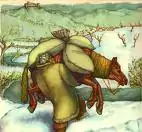Martin Krpan
Martin Krpan is a fictional character created on the basis of the Inner Carniolan oral tradition[1] by the 19th-century Slovene writer Fran Levstik in the short story Martin Krpan from Vrh (Slovene: Martin Krpan z Vrha). Published in 1858 in the literary journal Slovenski glasnik, the popularity of the story led to it becoming a part of Slovene folklore and made its lead character a folk hero.

The story
A Slovene subject of the Habsburg Empire and one of the strongest men in it, Martin Krpan hails from a fictional village in Inner Carniola, Hilltop by the Holy Trinity (Vrh pri Sveti Trojici). A smuggler by profession, he makes a living by illegally transporting English salt (gunpowder).[nb 1] With the help of his loyal, diminutive mare, they carry the gunpowder from the Adriatic Sea coast to the Slovene Lands and elsewhere in Inner Austria. On one of his travels, Krpan meets the imperial carriage on a snowbound road, and makes way for it by picking up his laden horse and moving it aside. His extraordinary strength is noted by the Emperor John (cesar Janez). Several years later, the Emperor summons Krpan to Vienna in order to fight as the Empire's last hope against Brdaus (Slovene: Brdavs), a brutal warrior who has set up camp outside the imperial capital and challenged all comers, and has already slain most of the city's knights, including the Crown Prince. Reluctantly, Krpan accepts the challenge, scandalizing the court with his uncouthness, honesty and homespun manner, before defeating the brute in a duel by using both his strength and his ingenuity. In gratitude, the Emperor gives him a special permit to legally traffic in English salt and as well as a pouch of gold pieces, he also gave him permission to marry his daughter.[3]
Figural representations

The story of Martin Krpan as rendered by Levstik in his epic poem was first illustrated in 1917 by Hinko Smrekar. Today, Smrekar's illustrations are mainly known from the images on tarot playing cards.
In 1954, the expressionist painter Tone Kralj created a series of large full-page color illustrations of the story. His picture book, reprinted thirteen times, is now the most recognisable image of Martin Krpan.[4]
Krpan is often depicted carrying his mare, a reference to in an iconic scene from the story in which he moves his horse to make way for the imperial carriage.
Notes
- The exact nature of this substance is a matter of dispute: it might have been magnesium sulfate or ammonium carbonate.[2]
References
- Ambivalent Dealings with an Imperial Past: The Habsburg Legacy and New Nationhood in ex-Yugoslavia
- Amonijak (in Slovene)
- Martin Krpan - In Slovenian Post's stamps
- "Archived copy". Archived from the original on 2004-07-23. Retrieved 2012-10-23.CS1 maint: archived copy as title (link)
External links
| Slovenian Wikisource has original text related to this article: |
| Wikimedia Commons has media related to Martin Krpan. |
- Martin Kerpan z Verha. The original story published in Slovenski glasnik (1858).
- Martin Krpan - summary of the story
